
A paper published in the journal Neuroscience & Biobehavioral Reviews is gaining increased attention in media. The paper, “The Social Nature of Mitochondria: Implications for Human Health,” focuses on mitochondria, which are organelles within cells. They have their own genome and generate the chemical energy needed to power life processes within the cell. Think of them as batteries that make a cell go.
The paper argues about some aspects of the mitochondria that touch on the philosophies deeply linked to a pagan awareness of nature.

Diagram of an animal mitochondrion [Mariana Ruiz Villarreal, public domain]
The paper is a review of scientific literature. The researchers argue that the mitochondria may do more than simply power the cells that keep us alive. They suggest that mitochondria are somehow interconnected with each other and are able to communicate and interact as social organisms – in other words, that the mitochondria have lives of their own.
“Sociality has profound evolutionary roots and is observed from unicellular organisms to multicellular animals,” Dr. Martin Picard, associate professor of behavioral medicine at Columbia University Irving Medical Center, and Dr. Carmen Sandi, of Swiss Federal Institute of Technology Lausanne, write. “In line with the view that social principles apply across levels of biological complexity, a growing body of data highlights the remarkable social nature of mitochondria.”
The idea that mitochondria display social traits suggests that they hold the potential at least for decisions and motivations, which itself raises a question of consciousness. “Similar to individuals among social networks,” researchers note, “mitochondria communicate with each other and with the cell nucleus, exhibit group formation and interdependence, synchronize their behaviors, and functionally specialize to accomplish specific functions within the organism. Mitochondria are social organelles.”
That social activity may have consequences at much larger scales. The researchers noted that the perspective of social mitochondria impacts “our understanding of human health and behavior.” It does so because the mitochondria are interacting and communicating with each other among their social networks and could impact aspects of human health like disease processes.
The authors note that the objective of the paper is to present a theoretical shift in our understanding of biology to emphasize the role of interdependence and communication. By presenting their hypothesis, they hope to facilitate interdisciplinary conversations that could lead to more “holistic and accurate models of human health.”
By suggesting that theoretical shift, however, the researchers also raise perhaps the most fundamental question within neuroscience: how does consciousness arise from biochemistry? Science has no answer to this question.
To be clear, answering this conundrum was not the researchers’ objective, and there is nothing in the published paper to directly address it. What raises the question is mulling through the idea that the mitochondria are reacting and organizing.
There are fundamentally two views of consciousness: materialism and dualism. Materialists insist that physical matter is all there is and consciousness emerges from a physical brain.
Dualists disagree and suggest that consciousness exists on its own – that is, consciousness and matter are separate.
The binary perspective of consciousness has not been scientifically fruitful: neither perspective can describe how we understand consciousness. The materialists cannot explain how consciousness emerges from chemistry, and the dualists cannot explain how consciousness interacts with chemistry.
Panpsychism, however, has recently become a trending topic in science news. Panpsychism suggests that everything is consciousness, a “view that mentality is fundamental and ubiquitous in the natural world.” This perspective has a long and central place in both Eastern and Western philosophical traditions. In the West, early pre-Socratic philosophers began addressing questions of the nature of consciousness by developing what would be called by the early philosopher Thales the “ubiquity of animation.”
As the Stanford Encyclopedia of Philosophy notes:
“For its proponents panpsychism offers an attractive middle way between physicalism on the one hand and dualism on the other. The worry with dualism—the view that mind and matter are fundamentally different kinds of thing—is that it leaves us with a radically disunified picture of nature, and the deep difficulty of understanding how mind and brain interact. And whilst physicalism offers a simple and unified vision of the world, this is arguably at the cost of being unable to give a satisfactory account of the emergence of human and animal consciousness. Panpsychism, strange as it may sound on first hearing, promises a satisfying account of the human mind within a unified conception of nature.”
This perspective is deeply pagan, but found in other religious perspectives as well. It continues to inform both our understanding of the world and is now increasingly prevalent in scientific conversations.
Panpsychism, at least in the form as it is starting to be used in scientific conversations, does not suggest that the same level of consciousness is found everywhere. A grain of sand does not have the same consciousness as a beetle, nor would a human have the same level of consciousness as a higher species, say a cat. But it does argue that a common elementary consciousness is pervasive throughout the universe.

A person wearing glasses and a blue shirt sits, deep in thought [Pixabay]
Christof Koch, the author of The Feeling of Life Itself, wrote in MIT Press Reader about how consciousness is observable everywhere. He notes that consciousness is experience. He highlights a theoretical framework developed by Giulio Tonini in 2004 that is still being revised called integrated information theory (IIT). The mathematical approach begins with consciousness rather than matter and then suggests the properties of physical systems to manifest consciousness.
“Some level of experience can be found in all organisms,” writes Koch, “including perhaps in Paramecium and other single-cell life forms. Indeed, according to IIT, which aims to precisely define both the quality and the quantity of any one conscious experience, experience may not even be restricted to biological entities but might extend to non-evolved physical systems previously assumed to be mindless — a pleasing and parsimonious conclusion about the makeup of the universe.”
Some critics have argued that consciousness does not even exist. “I remain unpersuaded, and I’m not alone in this,” British philosopher Keith Frankish wrote. “Panpsychism offers no distinctive predictions or explanations. It finds a place for consciousness in the physical world, but that place is a sort of limbo. Consciousness is indeed a hard nut to crack, but I think we should exhaust the other options before we take a metaphysical sledgehammer to it.”
“Consciousness, in that sense, is not everywhere but nowhere,” added Frankish.
Though Koch describes IIT as “the only really promising fundamental theory of consciousness,” a scientific theory is only as good as the observable evidence it organizes. There is still much more evidence to accumulate and many more experiments to run.
It seems unlikely there will be answers soon. In the meantime, the dialogue is wonderful and gives others a chance to contemplate what have always been pagan mysteries.
Author’s note: Yes, I know. It also sounds like midi-chlorians.
The Wild Hunt is not responsible for links to external content.
To join a conversation on this post:
Visit our The Wild Hunt subreddit! Point your favorite browser to https://www.reddit.com/r/The_Wild_Hunt_News/, then click “JOIN”. Make sure to click the bell, too, to be notified of new articles posted to our subreddit.